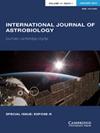保护海洋世界:欧罗巴快船行星保护输入到基于概率风险的方法
IF 1
4区 物理与天体物理
Q3 ASTRONOMY & ASTROPHYSICS
引用次数: 1
摘要
人们对探索具有海洋世界的行星体越来越感兴趣,航天器的行星保护(PP)实践对于避免这些敏感环境的有害生物污染非常重要。2018年秋季,一组不同的主题专家聚集在一起,研究欧罗巴快船项目概率风险模型引用的环境输入参数(例如空间辐射、欧罗巴表面周转率)和生物输入参数,以评估来自NASA程序要求8020.12D的< 1 × 10−4污染概率要求。2018年11月13日至15日,nasa和jpl联合召开了名为“Europa Clipper行星保护研讨会”的联合牵头研讨会,以验证概率模型输入值、当前Europa Clipper PP要求和实施策略,并确定未来PP研究主题。为期3天的研讨会的三个目标是:(1)验证欧罗巴快船PP污染建模框架的概率;(2)就污染模型输入值的概率达成一致,或就导出/识别适当模型输入的计划达成一致;(3)就未来PP研究计划及其优先级制定车间共识。讲习班与会者进行了详细的科学和工程讨论,重点是克利伯号任务目标和轨迹、欧罗巴冰壳地球物理学以及了解初始微生物生物负荷的影响和航天器清洁度,讲习班结束前成功完成了所有三个目标。本文章由计算机程序翻译,如有差异,请以英文原文为准。
Protecting ocean worlds: Europa Clipper planetary protection inputs to a probabilistic risk-based approach
There is increased interest in exploring planetary bodies that have ocean worlds, and planetary protection (PP) practices for spacecraft are important to avoid harmful biological contamination of these sensitive environments. In the autumn of 2018 a diverse set of subject matter experts were assembled to examine the environmental input parameters (e.g. space radiation, Europa surface turnover) and biological input parameters that are referenced by the Europa Clipper project probabilistic risk model, to assess the < 1 × 10−4 probability of contamination requirement derived from NASA Procedural Requirements 8020.12D. A joint NASA–JPL lead workshop entitled, ‘Europa Clipper Planetary Protection Workshop’ was convened on 13–15 November 2018, to validate probability model input values, current Europa Clipper PP requirements and implementation strategy, and identify future PP research topics. The three objectives for the 3 day workshop were: (1) to validate the probability of contamination modelling framework for Europa Clipper PP; (2) to agree on probability of contamination model input values, or on a plan to derive/identify appropriate model inputs and (3) to develop workshop concurrence regarding future PP research plans and their priority. Workshop participants engaged in detailed scientific and engineering discussions focusing on Clipper mission objectives and trajectories, Europan ice shell geophysics and understanding the impact of initial microbial bioburdens and spacecraft cleanliness with all three objectives being successfully completed by the end of the workshop.
求助全文
通过发布文献求助,成功后即可免费获取论文全文。
去求助
来源期刊

International Journal of Astrobiology
地学天文-地球科学综合
CiteScore
3.70
自引率
11.80%
发文量
45
审稿时长
>12 weeks
期刊介绍:
International Journal of Astrobiology is the peer-reviewed forum for practitioners in this exciting interdisciplinary field. Coverage includes cosmic prebiotic chemistry, planetary evolution, the search for planetary systems and habitable zones, extremophile biology and experimental simulation of extraterrestrial environments, Mars as an abode of life, life detection in our solar system and beyond, the search for extraterrestrial intelligence, the history of the science of astrobiology, as well as societal and educational aspects of astrobiology. Occasionally an issue of the journal is devoted to the keynote plenary research papers from an international meeting. A notable feature of the journal is the global distribution of its authors.
 求助内容:
求助内容: 应助结果提醒方式:
应助结果提醒方式:


